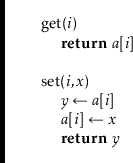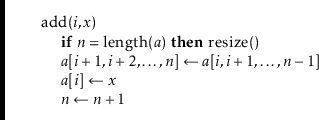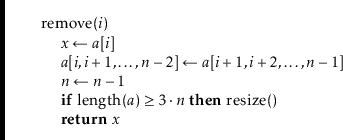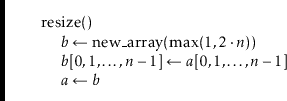Next: 2.2 FastArrayStack: An Optimized Up: 2. Array-Based Lists Previous: 2. Array-Based Lists Contents Index
An ArrayStack implements the list interface using an array
![]() , called
the backing array. The list element with index
, called
the backing array. The list element with index
![]() is stored
in
is stored
in
![]() . At most times,
. At most times,
![]() is larger than strictly necessary,
so an integer
is larger than strictly necessary,
so an integer
![]() is used to keep track of the number of elements
actually stored in
is used to keep track of the number of elements
actually stored in
![]() . In this way, the list elements are stored in
. In this way, the list elements are stored in
![]() ,...,
,...,
![]() and, at all times,
and, at all times,
![]() .
.

Accessing and modifying the elements of an ArrayStack using
![]() and
and
![]() is trivial. After performing any necessary bounds-checking
we simply return or set, respectively,
is trivial. After performing any necessary bounds-checking
we simply return or set, respectively,
![]() .
.

The operations of adding and removing elements from an ArrayStack
are illustrated in Figure 2.1. To implement the
![]() operation, we first check if
operation, we first check if
![]() is already full. If so, we call
the method
is already full. If so, we call
the method
![]() to increase the size of
to increase the size of
![]() . How
. How
![]() is implemented will be discussed later. For now, it is sufficient to
know that, after a call to
is implemented will be discussed later. For now, it is sufficient to
know that, after a call to
![]() , we can be sure that
, we can be sure that
![]() . With this out of the way, we now shift the elements
. With this out of the way, we now shift the elements
![]() right by one position to make room for
right by one position to make room for
![]() ,
set
,
set
![]() equal to
equal to
![]() , and increment
, and increment
![]() .
.
![\includegraphics[scale=0.90909]{figs-python/arraystack}](img495.png)
|

If we ignore the cost of the potential call to
![]() , then the cost
of the
, then the cost
of the
![]() operation is proportional to the number of elements we
have to shift to make room for
operation is proportional to the number of elements we
have to shift to make room for
![]() . Therefore the cost of this operation
(ignoring the cost of resizing
. Therefore the cost of this operation
(ignoring the cost of resizing
![]() ) is
) is
![]() .
.
Implementing the
![]() operation is similar. We shift the elements
operation is similar. We shift the elements
![]() left by one position (overwriting
left by one position (overwriting
![]() ) and
decrease the value of
) and
decrease the value of
![]() . After doing this, we check if
. After doing this, we check if
![]() is getting
much smaller than
is getting
much smaller than
![]() by checking if
by checking if
![]() . If so,
then we call
. If so,
then we call
![]() to reduce the size of
to reduce the size of
![]() .
.

If we ignore the cost of the
![]() method, the cost of a
method, the cost of a
![]() operation is proportional to the number of elements we shift, which
is
operation is proportional to the number of elements we shift, which
is
![]() .
.
The
![]() method is fairly straightforward; it allocates a new
array
method is fairly straightforward; it allocates a new
array
![]() whose size is
whose size is
![]() and copies the
and copies the
![]() elements of
elements of
![]() into
the first
into
the first
![]() positions in
positions in
![]() , and then sets
, and then sets
![]() to
to
![]() . Thus, after a call to
. Thus, after a call to
![]() ,
,
![]() .
.

Analyzing the actual cost of the
![]() operation is easy. It
allocates an array
operation is easy. It
allocates an array
![]() of size
of size
![]() and copies the
and copies the
![]() elements of
elements of
![]() into
into
![]() . This takes
. This takes
![]() time.
time.
The running time analysis from the previous section ignored the cost
of calls to
![]() . In this section we analyze this cost using a
technique known as amortized analysis. This technique does not
try to determine the cost of resizing during each individual
. In this section we analyze this cost using a
technique known as amortized analysis. This technique does not
try to determine the cost of resizing during each individual
![]() and
and
![]() operation. Instead, it considers the cost of all calls to
operation. Instead, it considers the cost of all calls to
![]() during a sequence of
during a sequence of ![]() calls to
calls to
![]() or
or
![]() .
In particular, we will show:
.
In particular, we will show:



There are two cases to consider. In the first case,
![]() is
being called by
is
being called by
![]() because the backing array
because the backing array
![]() is full, i.e.,
is full, i.e.,
![]() . Consider the previous call to
. Consider the previous call to
![]() :
after this previous call, the size of
:
after this previous call, the size of
![]() was
was
![]() , but the
number of elements stored in
, but the
number of elements stored in
![]() was at most
was at most
![]() .
But now the number of elements stored in
.
But now the number of elements stored in
![]() is
is
![]() ,
so there must have been at least
,
so there must have been at least
![]() calls to
calls to
![]() since
the previous call to
since
the previous call to
![]() .
.
The second case occurs when
![]() is being called by
is being called by
![]() because
because
![]() . Again, after the
previous call to
. Again, after the
previous call to
![]() the number of elements stored in
the number of elements stored in
![]() was
at least
was
at least
![]() .2.1 Now there
are
.2.1 Now there
are
![]() elements stored in
elements stored in
![]() . Therefore, the number
of
. Therefore, the number
of
![]() operations since the last call to
operations since the last call to
![]() is at least
is at least
The following theorem summarizes the performance of an ArrayStack:
The ArrayStack is an efficient way to implement a Stack.
In particular, we can implement
![]() as
as
![]() and
and
![]() as
as
![]() , in which case these operations will run in
, in which case these operations will run in ![]() amortized time.
amortized time.